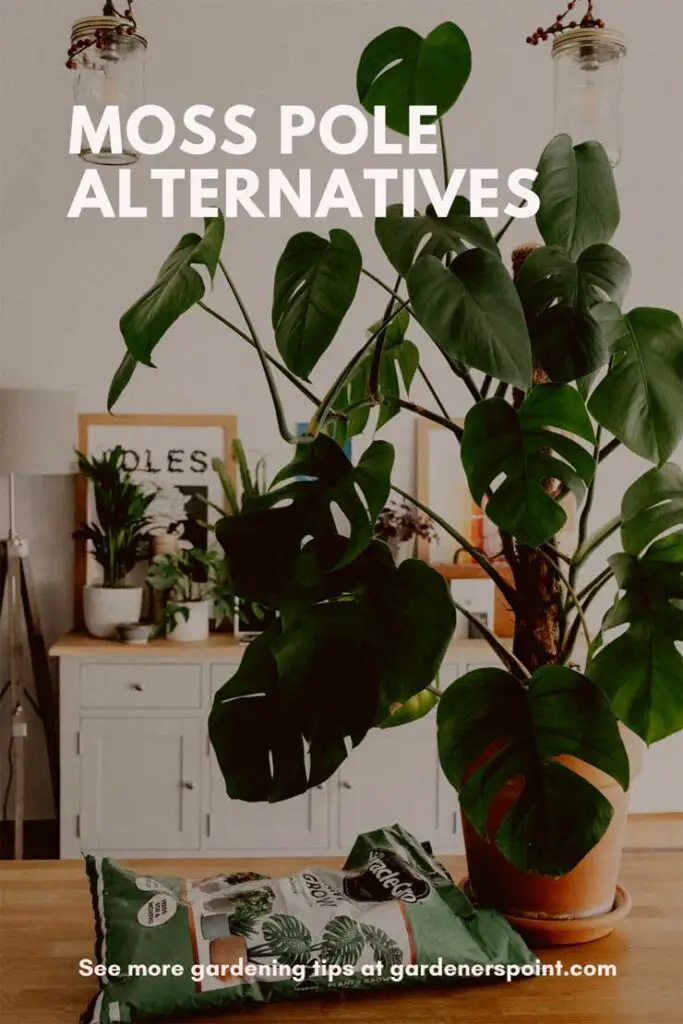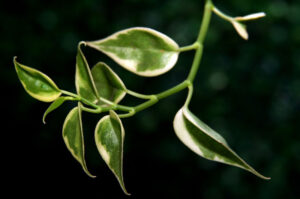10 best Moss Pole Alternatives- Perfect For Your Climbing Plants
Moss poles are great options for you if you have a trailing vine or a beautiful epiphyte. They really provide good support to your climbers. But some people don’t like the weird fishnet stockings look of the moss poles. So in this blog post, we are going to discuss ten better options you can use instead of a moss pole. Here are they.
There are a variety of moss pole alternatives, such as bamboo trellises, coir poles, PVC pipes, wooden slabs, metal pipes, plastic frames, metal trellises, etc. You can choose any of these moss pole alternatives to support your plants. Most of these options are inexpensive and are readily available from your surroundings.
Let’s get into the details of what moss poles are, their significance, and popular alternatives to moss poles:

What are moss poles?
Moss poles are vertical, slim rods that provide support to climber plants. Moss poles are usually made up of natural materials like bamboo and are incredibly lightweight and convenient to install.
They are an ideal surface for vines and other climbers to attach to. Plants’ roots also enjoy gripping the rough and textured surface of moss poles. These poles are an excellent boon for gardeners because they provide water and nutrients to the plants.
Moss poles are a perfect fit for outdoor as well as indoor plants. Many plant parents use these poles for their houseplants to give them the right direction and to save space.
Do Plants like moss poles?
Yes, some plants like tall vegetables, air plants, and all climbers like moss poles. Some of the examples of such plants are:
- Tomatoes
- Monsteras
- Climbing rose
- Squash
- Pole beans
- Philodendrons
- Ivy
- Arrowhead plants
- Pothos
- Clematis
Why choose the moss pole alternative?
Though some plants do exceptionally well with moss poles, many gardeners prefer not to use them. Instead, they like alternatives to moss poles like bamboo, wood, metal pipe, etc. There are various reasons for avoiding moss poles, such as:
- Some plant parents find moss poles unpleasant to look at.
- Climbers with aerial roots often find it challenging to climb moss poles until you manually attach your plants to moss and train them to climb.
- Moss poles often catch molds, damaging your healthy plants.
- Sometimes plant has outgrown the existing moss pole they have, and these people don’t want to extend their moss pole, again and again, rather they want a permanent solution, as a replacement for their moss poles.
Ten alternatives to a moss pole
Here is a list of other options that you can use in place of moss poles. You can select any option according to your requirements:
1. A Tree Slab
A tree slab or a natural bamboo trellis is the perfect alternative for your moss pole. The outer portion of a tree slab, of a live edge wood, would be an ideal choice to replace your moss pole. This tree slab will mimic the natural habitat of your trailing vines as if they are growing on a tree trunk. Apart from this, a natural bamboo trellis can also be a nice alternative to your moss poles.
A tree slab or a wood slab adds a natural vibe when placed near your climbers, and by doing a little customization here and there, you can be also more creative in making an artificial jungle inside your room. Also, it will take years for your vines to outgrow these tree slabs or logs.
Tree slabs/ Wooden slabs
The outer portion of a tree slab of a live edge wood is a perfect choice to replace your moss poles. Generally, when carpenters are making various things like tables, chairs, etc. they take large pieces of wooden logs and cut the outer portion of the wood to get a flat and smooth-surfaced wood.

So the outer portion of the live edge wood slab is of no use for the carpenters. It is a scrap for them. You can go and grab them at a very cheap price and use them as your moss pole alternatives.
From where can to find a wooden slab
Go to your Facebook marketplace and search for wooden slabs. From there you can find some great options for tree slabs. Search for the outer portion of a live edge wood slab, which you can get for a very cheap price.
Because these side wooden slabs are formed as a byproduct in the process of cutting the wooden logs and giving them a perfect shape to make wooden furniture. So these are scraps for the carpenters. They sell it out at a very low price.
Also, you can visit your nearest carpenter shop or furniture workshop, and collect such types of wooden slabs directly from there. You can get a perfect piece of tree slab from there at a very cheap price.
After finding a perfect wooden slab, you have to do some minor tweaking to the wood to make it perfect for your vining plants. Here is a video from The Adhd Gardener, on YouTube. She has nicely explained how to make a perfect wooden slab for your indoor vining plants. Do check it out.
Step-by-step process
Here is a step-by-step process, on how to make a perfect tree slab for your trailing vines, that can replace a moss pole.
a. Remove the outer bark
After getting a wood slab, the first thing you have to do is to remove the outer bark of the slab. It is an important step to do. Because the bark might store some of the harmful insect pests inside it. It might infect your indoor plants severely.
Also, it is not possible to preserve the bark for longer periods. It is surely going to dry out and flake off, creating problems for your vines.
So it is a wise decision to remove the outer bark and its residuals from the wood slab.
Use a knife or any sharp object to remove all the bark from the wood slab.
b. Sanding
Rub the surface of the slab with sandpaper to make it smooth and attractive. It will remove all the sharp edges that might form in the process of bark removal.
c. Staining
You can add the desired color to the wooden slab by staining it. You can skip this step if you just like the natural color it has. It is an optional step.
Staining really enhances the grain pattern and texture of your wood and increases the aesthetic appeal of the slab.
Choose a perfect wood stain according to your need, apply it to your wood, and leave it for some time. Allow it to dry. It might take from several hours to a few days to complete the process of staining.
To get more insights about how to stain a wood you can CLICK HERE.
d. Sealing the wood
After applying the stain, now it is time to apply a topcoat sealant to protect the stained wood from unwanted scratches and fading over time. It will maintain the shine of the stained wood for years and years.
You can do this by applying one or two coatings of polyurethane, using a brush. After applying the sealant, keep it for drying. It will take one to two days to dry the polyurethane completely and you will then get a beautiful shiny wooden slab, to replace your moss pole.
Staining and sealing also preserve the wood from decaying. They also check the termite attack on your wood slab.
e. Anchor and decorate
Now your wooden slab is ready. Choose a place where you want to keep the slab. Fix the wood against your wall by using some hooks and twines or threads, so that the big wooden slab wouldn’t move here and there.
After fixing the tree slab, keep your vines around it, and then decorate them by putting them on the slab. You can use some twines or threads to attach the plant to the wood.
This wooden slab can perfectly replace your moss pole and also enhance the beauty of your climbers.
Pros
- Natural
- Easily available
- Inexpensive
- Eco friendly
- Most sustainable option
Cons
- Can attract insects and bugs
- If not properly cleaned, it can develop mildew and mold.
2. Bamboo trellis
It is a quick and cheap replacement for your moss poles. These bamboo trellises are easily available online from amazon. Other than these, you can also use other trellises available online.
Their only function is to provide support to your beautiful trailing vine.
Be careful at the time of inserting these bamboo trellises into the potting soil of your plant. Otherwise, you will end up piercing the roots beneath the soil. So the bamboo trellises are to be inserted very carefully.
One more thing you have to consider while using these alternatives to moss poles is that you have to water your plant more frequently. You have to spend more time spraying your plant and keeping them humid.
Because moss poles have the tendency to stay wet for long times, the alternatives don’t. So to provide an adequately moist environment, you have to water more often.
How to install it?
- Cut bamboo sticks as per your requirements.
- Using a lashing cord, secure these sticks in place.
- Carefully weave your climbers around these bamboo trellises.
- The climbers will finally find their way upward.
Pros
- Simple to cut into the desired length
- Inexpensive
- Lightweight
- You can easily customize them into varying lengths and shapes like a teepee, cage shape, etc.
Cons
- Do not provide nutrients to your plants
3. PVC pipes
PVC pipes are a good option for people looking out for sturdy support irrespective of the look. Though they don’t look good and leach harmful chemicals into the soil, they are weather resistant.
These pipes are, therefore, a popular choice among plant parents. But if the chemical leaching issue bothers you, you can regularly repot your plants.
Also, if you are too concerned about the look, use creativity and paint them like bamboo or make some floral designs.
But if you suck at creativity, you can wrap the PVC pipes with wire mesh and cover them with sphagnum moss.
Do whatever suits you because plants like ivy, Fiscus, and philodendrons love climbing these poles.
Hack: Interestingly, you can drill holes into your PVC pipes before wrapping them into moss, turning them into self-watering poles.
How to install it?
- Cut the pipe to the desired length.
- Cover it with Sphagnum moss.
- Wrap the pipe with wire mesh and secure it with zip ties.
- Insert the PVC pole into the center of the pot.
- You can tie the plant if it need be.
- Water your plants.
Pros
- Cost-effective
- Provides good support
- You can easily cut the desired length
- Strong and durable
Cons
- Chemicals can leach into the soil from PVC pipes
- Looks unpleasant
4. Wooden stakes
Wooden stakes or poles are an excellent alternative to moss poles. If you want a sturdy, natural, low-maintenance option, go for wooden stakes.
They offer a tidy and rustic look to your home. To make one, you only need a 20-40cm wooden pole and sphagnum moss. Wood stakes are best for plants with heavy tops and single stalks, such as sunflowers, corn plants, canna lilies, etc.
How to install it?
- Take the wooden pole and wrap it with Sphagnum moss.
- Secure the moss using chicken wire.
- Insert the pole into your pot.
- Carefully attach the plants to the pole using tape.
- Water the pole until it’s moist.
Pros
- Natural alternative
- Provide nutrition
- You get good vibes
- You can get them for free, or you can order online.
Cons
- Using chemically treated food can be harmful to plants
- Do not provide as many nutrients as a moss pole would.
- Attract insects and pests.
5. Wooden board
The wooden board is the minimalist variation of a tree slab. It is simply a wooden plank/board to help climbers wrap around it. The wooden plant should be small enough to fit into your pot.
But here’s the catch, you need first to place the wooden plank before adding the plant to your pot. It will help prevent the roots from getting disrupted. Be careful to opt for a word that isn’t resistant.
How to install it?
- Find a plant suitable for your plant needs.
- Place the slab in the bottom of the pot.
- Add soil to your pot and place the root ball in the pot’s center.
- Fill the pot with soil to cover the roots.
- You can and down all the sharp edges to give it a refined look.
6. Metals pipes
Another weather-resistant alternative to moss poles is metal pipes. It works the same as PVC pipes but is better to look at. You can take non-corrosive copper, aluminum, or stainless steel pipes.
They form the support base, and you can beautify them by wrapping them in natural products like jute, coir, or other raw fibrous material.
An added advantage of the metal pipes is that they don’t leave chemicals in the soil, so you need not worry about soil deterioration. Additionally, they require less maintenance than wooden poles and are less susceptible to damage.
However, the metal pipes are difficult to deal with because cutting them to the desired length is tricky. Also, plants are not comfortable latching onto them.
Lastly, remember not to take painted or oily pipes as these can damage the plants when the pipes come in contact with moisture.
How to install it?
- Cut the metal pole as per your requirements.
- Wrap them with Sphagnum moss.
- Use cable ties or chicken wires to secure it in place.
- Gently insert your metal pole into the soil.
- Tie your plant to the pole.
Pros
- Looks elegant
- Simple installation
- Stronger and durable
- No chemicals leach out of these pipes
- Weather-resistant
Cons
- Plants have difficulty climbing them
- They are challenging to deal with
7. Coir poles
Coir poles are a terrific replacement for moss poles; you can make them using coconut fiber. Hence, they are renewable and sustainable resources. As coconut fibers are a natural and eco-friendly product, it is an added advantage of coir poles.
And not to forget the strength and durability of this coir that make them an ideal choice for heavy plants. Also, their attractive look makes them aesthetically pleasing to the eyes.
Their resistance to molds and rot makes coir poles different from moss poles. But they can leach salt into the soil, so you must alter your fertilizing routine. You can either buy these poles online/offline or make one yourself.
How to install it?
- You need a solid base to make coir poles; hence a wooden stock is recommended to give your stake more stability.
- Take a wooden stick of the desired length.
- Break down the coir into small, manageable pieces.
- Wrap these choir pieces around the wooden stick and tie them securely to the pole.
- Carefully insert the pole into the center of your pot and water the plant until moist.
Pros
- More durable than moss pole
- Has good water retention capacity
- Perfect to use outdoors
Cons
- Leach salt into the soil
8. Plastic trellises
Plastic trellises are another great option to replace moss poles. They are a budget-friendly option. You can roll them into a circle and put them in the pot along the edges between the plant and the soil. Doing so will ensure that the plant grows in the center of the pot.
You may also need extra support from bamboo sticks if the plants are heavy or oversized. Also, remember not to overload your plastic trellis to avoid damaging your plants.
How to install it?
- Roll and tie the plastic trellis into a circle.
- Insert them in the pot around the peripheries of the soil.
- You can add a bamboo stick, too, for added support.
- Use strings to attach your plants to the trellis.
- Water to moisten the soil.
Pros
- Easily available
- Easy installation
- Inexpensive
Cons
- Plastic is not an eco-friendly product
9. Wire trellises
Wire trellises are indeed an excellent replacement for most poles. But go for a wire that is easy to bend and can take the required shape, like chicken wire.
The wire has tiny openings that allow vines to grip and climb the trellis easily. You can roll the chicken wire in a circle and place it on your top. You’ll be amazed to see how nature does its wonders; climbers start gripping the trellis and climb conveniently.
How to install it?
- Start by rolling the chicken wire into a circle.
- Place this rolled wire in the pot and insert it a bit to avoid getting it misplaced.
- Attach the climbers to the trellis.
- Water them as per needs.
Pros
- Pocket friendly
- Easily available
- Hassle-free installation
Cons
- Not easily available
10. Bean poles
Bean poles should be your go-to option if you want to create a perfect trellis for climbers. Though they are specifically designed to support beans, you can use them for keeping all growing vines.
They are tall and sturdy structures and require minimal maintenance once installed. Moreover, they give a beautiful display to your climbers and maximize your space.
How to install it?
- Take three equal-sized bean sticks and insert them into the planter containing the plant.
- Make sure the sticks are slightly angled.
- Keep the plant and stick securely by using ties or strings.
Pros
- Inexpensive
- An easy DIY
- Need minimum maintenance
Cons
- Though you can use them to support other plants, they perform exceptionally well, specifically for beans.
Final words
Moss poles are a wise option to make your plants look more attractive and add height. And if you don’t want to use moss, we have suggested 10 attractive alternatives to moss poles.
Moss pole alternatives can be anything you can insert in the soil and support your plants. Also, most alternatives are inexpensive, so you can easily install them without digging deep into your pockets.
But if you choose an option like coir or tree beaches that provides nutrition while supporting the plant, that would be a terrific choice. So let your creative juices flow and see what alternative suits you best!






